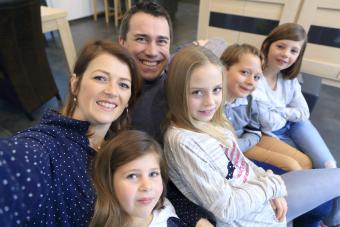
All you have to do is look around a school open house to see that family structure has changed dramatically over the last 50 years. Family units are far more diverse, proving that there are all kinds of ways to be a loving family today.
The Leave It to Beaver family (with a mom, dad, and two or three kids) is no longer the standard. In fact, the US doesn't currently have a single family type that's considered the norm. There are several variations on family, including single-parent households, families without kids, and many more. There are six specific types of family structures identified by society today.
What Is a Family Structure?
A family structure, or family unit, is the basic grouping of members in a family. There are lots of types of families that exist today, with some families naturally falling into multiple categories. For example, you might live in a single-parent family but also be a part of a larger, extended family.
While these types of families are distinct in definition, in practice, the lines are less clear. As laws and norms change, so do family structures. For example, the 2020 U.S. Census was the first to give respondents the chance to indicate that they are part of a same-sex couple, either married or unmarried.
Nuclear Family

The nuclear family is the traditional type of family structure you might think of. This family type consists of two parents and at least one child. Society has long held the traditional nuclear family in high esteem as being the 'ideal' in which to raise children.
Today, we know there are lots of ways to raise healthy and happy kids, but there are a few reasons this type of family unit works. Children in nuclear families often receive strength and stability from the two-parent structure (when one parent needs a break, as we all do, the other parent can step in).
Generally, kids in these types of families have more opportunities due to the financial ease of incomes from two adults. In America today, less than 46 percent of families live in a nuclear family unit where both parents are on their first marriage, according to the Pew Research Center.
There's actually a lot of variation in how a nuclear family can look. This type of family can include any kind of commitment between the two parents, not just marriage. And the parents can be different genders, the same gender, or not gender binary.
Single-Parent Family

The single-parent family consists of one parent raising one or more children on their own (although they may have support from friends and other family members not living with them). This family unit may include a single mother with her children, a single dad with his kids, or a single person with their kids.
The single-parent family is the biggest alteration society has seen in terms of the changes in family structures. One in four children is born to a single mother, according to Pew. Single-parent families are often close and find ways to work together to solve problems, such as dividing up household chores.
When only one parent is at home, it may be a struggle to find childcare, as there is only one parent working. This limits income and opportunities in many cases, although many single-parent families have support from relatives and friends.
Extended Family

The extended family structure consists of two or more adults who are related, either by blood or marriage, living in the same home. This family includes many relatives living together and working toward common goals, such as raising the children and keeping up with the household duties. Many extended families include cousins, aunts or uncles, and grandparents living together.
This type of family structure may form due to financial difficulties or because older relatives are unable to care for themselves alone. Extended families are becoming increasingly common all over the world.
Families Without Children

While many people think of a family as including children, there are couples who either cannot or choose not to have children. This doesn't make them less of a family, and in fact, this type of family unit is on the rise. 44 percent of non-parents under age 50 report not planning to ever have children, and this includes people in committed relationships.
The family without children is sometimes the "forgotten family," as it does not meet the traditional standards set by society. Childless families consist of two partners living and working together. Many families without children take on the responsibility of pet ownership or have extensive contact with their nieces and nephews.
Stepfamily

Over half of all marriages end in divorce, and many of these individuals choose to get remarried. This creates the step or blended family, which involves two separate families merging into one new unit. It consists of a new husband, wife, or spouse and their children from previous marriages or relationships.
If you're part of a stepfamily, you're not alone. Stepfamilies are about as common as the nuclear family, although they tend to have unique challenges, such as adjustment periods and discipline issues. Stepfamilies need to learn to work together and also work with their exes to ensure these family units run smoothly.
Grandparent Family

Many grandparents today are raising their grandchildren for a variety of reasons. One in ten children lives with a grandparent, and about one in five is raised by their grandparents. In these situations, the parents may be present in the child's life, but they are not the child's primary guardian.
The grandparent family unit, also known as a skipped-generation family, is sometimes due to parents' death, addiction, abandonment, or being deemed unfit parents. Many grandparents need to go back to work or find additional sources of income to help raise their grandchildren.
Family Structures and Units Can Take on Different Forms
There's no right or wrong answer when it comes to what is the best type of family structure, and even a traditional nuclear family has pros and cons. What a family unit looks like, just like what a family means, can mean different things to different people. As long as a family is filled with love and support for one another, it tends to be successful and thrive. Families need to do what is best for each other and themselves, and that can be achieved in almost type of unit.







